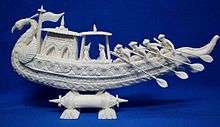Malakar
| Malakar | |
|---|---|
| Religions | Hinduism Traditional beliefs |
| Languages | Bengali, Hindi |
| Populated States | West Bengal, jharkhand, Bangladesh |
| Family names | Malakar |
Malakar (Bengali: মালাকার) is a Bengali Hindu surname spread throughout West Bengal and Bangladesh. The Malakars are traditionally garlander by trade. The governments of India and West Bengal both have classified Malakars under Other Backward Classes. [1]
Origin
Malakars lived around Dhaka and other smaller towns of Bengal. The origin of the word Malakar came from Sanskrit. It is a Sandhi of mala and akar, which means a person who shapes mala, i.e a garlander. They are expert shola craftsmen. The Malakars are one of the nine artisan class that constituted the Navashākha and for generations they are involved in this craft. The nine trading casts that constitutes Navashaka are Kumbhakar, Karmakar, Malakar, Kangsakar, Sankhakar, Swarnakar, Sutradhar, Chitrakar and Tantubaya. There is a legend associated with this caste, as H H Rishley writes in his book THE TRIBES and CASTES of BENGAL, "In Bengal the caste is included among the Nava Sakha and its members profess to trace their descent from the garland maker attached to the household of Raja Kansa of Mathura, who, when met by Krishna, was asked for a chaplet of flowers and at once gave it. On being told to fasten it with a string, he, for want of any other, took off his sacred thread and tied it, on which Krishna most ungenerously rebuked him for his simplicity in parting with his paita, and announced that for the future his caste would not be ranked among the Brahmins. Like others of the higher castes, the Malakars claim to have originally come from Mathura in the reign of Jahangir."



Occupation
Malakars were employed to provide garlands and flowers for the village deities and also for the religious and social functions of the society. The profession of a Malakir required a considerable knowledge of flowers, for some were forbidden to be used in religious services and others could only be exhibited before the shrines of the deities to whom they belonged. But their principal occupation used to be Sholapith craft, one of the primordial handicrafts of both the Bengals. Sholapith craft of West Bengal was recognized as one of the best example of elegance, exquisite beauty and finest craftsmanship. Like many other traditional crafts, it has its origin in the ritual and religious requirements of old days. In ancient time this artisans held a respectable position in society and used to supply the Daker Saaj for the regional deities on occasions. Sholapith items formed an integral part of the major religious rituals in West Bengal. Fine examples of craftsmanship can be seen during the Durga Puja celebrations. At marriages their services are indispensable, for they prepare the crowns called topor worn by the bridal pair. No puja or marriage could be celebrated without the floral decoration for the deities or the topor made by the Malakar. Every community in each village, town and city needed an idol as fine as they could afford, so the craft flourished there.
One of the chief occupations of this caste is inoculating for small-pox and treating individuals attacked by any eruptive fever.[2]

Religion and Rituals
Malakars are mainly Vaishnava by creed, Shaivism and Saktism are also found among Malakars. Malakars who have their ancestral origin in Dhaka have a single gotra, Alamyan.
During marriages, the bridal dress must be made up of red silk brought from Murshedabad. The bride is always carried in a palki or palanquin.
Eminent Malakars
- Sanjaya Malakar, an American born Bengali and Italian singer
See also
References
- ↑ "Government of West Bengal: List of Other Backward Classes". Govt. of West Bengal. Retrieved February 13, 2011.
- ↑ "Sholapith Craft of West Bengal: An Overview" (PDF).